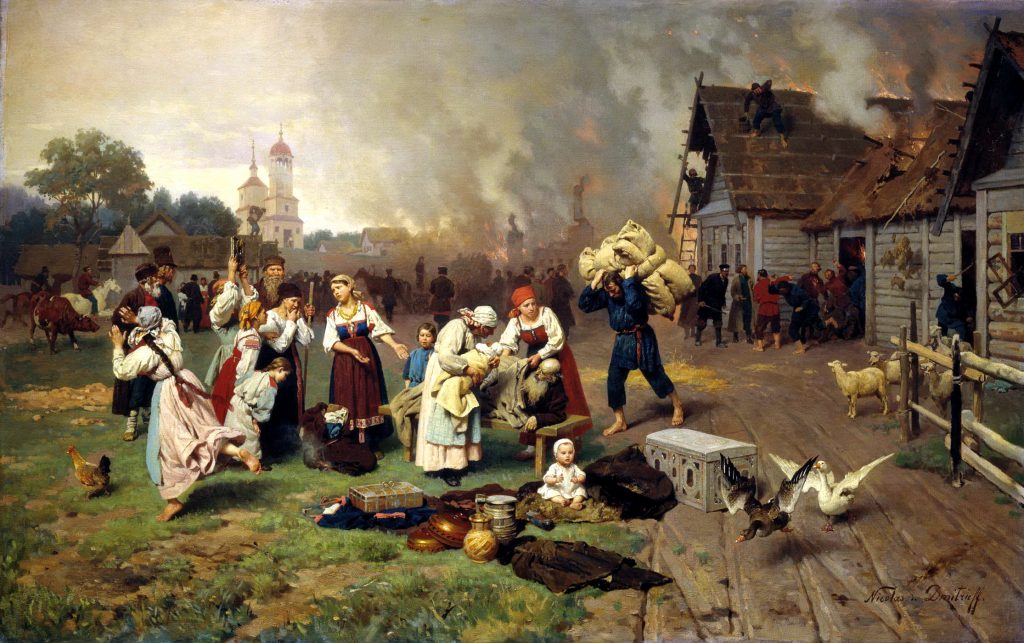Wilderness, Heat
Source: Paizo Blog.
Heat deals nonlethal damage that cannot be recovered from until the character gets cooled off (reaches shade, survives until nightfall, gets doused in water, is targeted by endure elements, and so forth). Once a character has taken an amount of nonlethal damage equal to her total hit points, any further damage from a hot environment is lethal damage.
A character in very hot conditions (above 90° F) must make a Fortitude saving throw each hour (DC 15, +1 for each previous check) or take 1d4 points of nonlethal damage. Characters wearing heavy clothing or armor of any sort take a -4 penalty on their saves. A character with the Survival skill may receive a bonus on this saving throw and might be able to apply this bonus to other characters as well (see the skill description). Characters reduced to unconsciousness begin taking lethal damage (1d4 points per hour).
In severe heat (above 110° F), a character must make a Fortitude save once every 10 minutes (DC 15, +1 for each previous check) or take 1d4 points of nonlethal damage. Characters wearing heavy clothing or armor of any sort take a -4 penalty on their saves. A character with the Survival skill may receive a bonus on this saving throw and might be able to apply this bonus to other characters as well (see the Survival skill in Using Skills). Characters reduced to unconsciousness begin taking lethal damage (1d4 points per each 10-minute period).
A character who takes any nonlethal damage from heat exposure now suffers from heatstroke and is fatigued. These penalties end when the character recovers from the nonlethal damage she took from the heat.
Extreme heat (air temperature over 140° F, fire, boiling water, lava) deals lethal damage. Breathing air in these temperatures deals 1d6 points of fire damage per minute (no save). In addition, a character must make a Fortitude save every 5 minutes (DC 15, +1 per previous check) or take 1d4 points of nonlethal damage. Those wearing heavy clothing or any sort of armor take a -4 penalty on their saves.
Boiling Liquid
Boiling water deals 1d6 points of scalding damage, unless the character is fully immersed, in which case it deals 10d6 points of damage per round of exposure.
Catching Fire
Characters exposed to burning oil, bonfires, forest fires, and non-instantaneous magic fires might find their clothes, hair, or equipment on fire. Spells with an instantaneous duration don’t normally set a character on fire, since the heat and flame from these come and go in a flash.
Characters at risk of catching fire are allowed a DC 15 Reflex save to avoid this fate. If a character’s clothes or hair catch fire, he takes 1d6 points of damage immediately. In each subsequent round, the burning character must make another Reflex saving throw. Failure means he takes another 1d6 points of damage that round. Success means that the fire has gone out-that is, once he succeeds on his saving throw, he’s no longer on fire.
Those whose clothes or equipment catch fire must make DC 15 Reflex saves for each item. Flammable items that fail take the same amount of damage as the character.
Extinguish
Source: Pathfinder Adventure Path volume #25: Bastards of Erebus

Core Rules: A character on fire may automatically extinguish the flames by jumping into enough water to douse himself. If no body of water is at hand, rolling on the ground or smothering the fire with cloaks or the like permits the character another save with a +4 bonus.
Adventure Path #25: Dousing a fire requires a large amount of water or other non-flammable material, such as dirt, to be deposited on the burning area. One effective strategy for extinguishing a fire quickly is to surround the burning area with nonflammable material. PCs doing this must make a ranged touch attack against an AC of 10 to deliver their payload to the intended square.
The following indicates how many 5-foot squares of fire a number of the listed containers can extinguish with successful delivery.
- Waterskin: Twenty waterskins full of water extinguish one square.
- Bucket: Four buckets full of non-flammable material extinguish one square.
- Gallon Container: Twelve gallon containers of nonflammable material extinguish one square.
- Cauldron: One cauldron of non-flammable material extinguishes one square.
- Portable Hole: A portable hole filled with non-flammable material extinguishes a 12-square-by-12-square area.
- Bag of holding: A bag of holding, type I filled with nonflammable material extinguishes a 3-square-by-3-square area, type II extinguishes a 5-square-by-5-square area, type III extinguishes a 7-square-by-7-square area, and type IV extinguishes a 10-square-by-10-square area.
Smoke
A character who breathes heavy smoke must make a Fortitude save each round (DC 15, +1 per previous check) or spend that round choking and coughing. A character who chokes for 2 consecutive rounds takes 1d6 points of nonlethal damage. Smoke obscures vision, giving concealment (20% miss chance) to characters within it.

 Buy me a coffee
Buy me a coffee